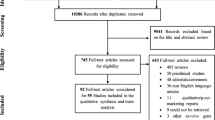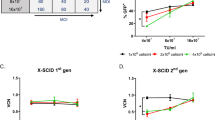Summary:
The concept of hematopoietic stem cell gene therapy is as exciting as that of stem cell transplantation itself. The past 20 years of research have led to improved techniques for transferring and expressing genes in hematopoietic stem cells and preclinical models now routinely indicate the ease with which new genes can be expressed in repopulating stem cells of multiple species. Both modified murine oncoretroviruses and lentiviruses transmit genes into the genome of hematopoietic stem cells and allow expression in the host following transplantation. Using oncoretroviruses, therapeutic genes for severe combined immunodeficiency, common variable gamma chain immunodeficiency, chronic granulomatous disease, Hurler's and Gaucher's Disease have all been used clinically with only modest success except for the patients with immunodeficiency in whom a partial T-cell chimerism has been dramatic. Since stem cell selection in vivo appears important to the therapeutic success of gene transfer, drug resistance selection, most recently using the MGMT gene, has been developed and appears to be safe. Future trials combining a drug resistance and therapeutic gene are planned, as are trials using safety-modified lentiviruses. The therapeutic potential of hematopoietic stem cell gene therapy, particularly given recent advances in stem cell plasticity, remains an exceptionally exciting area of clinical research.
This is a preview of subscription content, access via your institution
Access options
Subscribe to this journal
Receive 12 print issues and online access
$259.00 per year
only $21.58 per issue
Buy this article
- Purchase on Springer Link
- Instant access to full article PDF
Prices may be subject to local taxes which are calculated during checkout
Similar content being viewed by others
References
Goodell MA, Brose K, Paradis G et al. Isolation and functional properties of murine hematopoietic stem cells that are replicating in vivo. J Exp Med 1996; 183: 1797–1806.
Morel F, Galy A, Chen B et al. Equal distribution of competitive long-term repopulating stem cells in the CD34+ and CD34− fractions of Thy-1lowLin-/lowSca-1+ bone marrow cells. Exp Hematol 1998; 26: 440–448.
Osawa M, Hanada K, Hamada H et al. Long-term lymphohematopoietic reconstitution by a single CD34− low/negative hematopoietic stem cell. Science 1996; 273: 242–245.
Sato T, Laver JH, Ogawa M . Reversible expression of CD34 by murine hematopoietic stem cells. Blood 1999; 94: 2548–2554.
Koc ON, Lazarus HM . Mesenchymal stem cells: heading into the clinic. Bone Marrow Transplant 2001; 27: 235–239.
Deans RJ, Moseley AB . Mesenchymal stem cells: biology and potential clinical uses. Exp Hematol 2000; 28: 875–884.
Koc ON, Peters C, Aubourg P et al. Bone marrow-derived mesenchymal stem cells remain host-derived despite successful hematopoietic engraftment after allogeneic transplantation in patients with lysosomal and peroxisomal storage diseases. Exp Hematol 1999; 27: 1675–1681.
Baxter MA, Wynn RF, Deakin JA et al. Retrovirally mediated correction of bone marrow-derived mesenchymal stem cells from patients with mucopolysaccharidosis type I. Blood 2002; 99: 1857–1859.
Reyes M, Verfaillie CM . Characterization of multipotent adult progenitor cells a subpopulation of mesenchymal stem cells. Ann NY Acad Sci 2001; 938: 231–233 discussion 233–235.
Reyes M, Dudek A, Jahagirdar B et al. Origin of endothelial progenitors in human postnatal bone marrow. J Clin Invest 2002; 109: 337–346.
Kocher AA, Schuster MD, Szabolcs MJ et al. Neovascularization of ischemic myocardium by human bone-marrow-derived angioblasts prevents cardiomyocyte apoptosis, reduces remodeling and improves cardiac function. Nat Med 2001; 7: 430–436.
Roe T, Reynolds TC, Yu G et al. Integration of murine leukemia virus DNA depends on mitosis. EMBO J 1993; 12: 2099–2108.
Naldini L, Blomer U, Gallay P et al. In vivo gene delivery and stable transduction of nondividing cells by a lentiviral vector. Science 1996; 272: 263–267.
Akkina RK, Walton RM, Chen ML et al. High-efficiency gene transfer into CD34+ cells with a human immunodeficiency virus type 1-based retroviral vector pseudotyped with vesicular stomatitis virus envelope glycoprotein G. J Virol 1996; 70: 2581–2585.
Trono D . HIV accessory proteins: leading roles for the supporting cast. Cell 1995; 82: 189–192.
Farson D, Witt R, McGuinness R et al. A new-generation stable inducible packaging cell line for lentiviral vectors. Hum Gene Ther 2001; 12: 981–997.
Zielske SP, Gerson SL . Lentiviral transduction of P140K MGMT into human CD34(+) hematopoietic progenitors at low multiplicity of infection confers significant resistance to BG/BCNU and allows selection in vitro. Mol Ther 2002; 5: 381–387.
Miyoshi H, Smith KA, Mosier DE et al. Transduction of human CD34+ cells that mediate long-term engraftment of NOD/SCID mice by HIV vectors. Science 1999; 283: 682–686.
Woods NB, Fahlman C, Mikkola H et al. Lentiviral gene transfer into primary and secondary NOD/SCID repopulating cells. Blood 2000; 96: 3725–3733.
Hanenberg H, Xiao XL, Dilloo D et al. Colocalization of retrovirus and target cells on specific fibronectin fragments increases genetic transduction of mammalian cells. Nat Med 1996; 2: 876–882.
Hanenberg H, Hashino K, Konishi H et al. Optimization of fibronectin-assisted retroviral gene transfer into human CD34+ hematopoietic cells. Hum Gene Ther 1997; 8: 2193–2206.
Murray LJ, Young JC, Osborne LJ et al. Thrombopoietin, flt3, and kit ligands together suppress apoptosis of human mobilized CD34+ cells and recruit primitive CD34+ Thy-1+ cells into rapid division. Exp Hematol 1999; 27: 1019–1028.
Schilz AJ, Schiedlmeier B, Kuhlcke K et al. MDR1 gene expression in NOD/SCID repopulating cells after retroviral gene transfer under clinically relevant conditions. Mol Ther 2000; 2: 609–618.
Schiedlmeier B, Wermann K, Kuhlcke K et al. Human multidrug resistance-1 gene transfer to long-term repopulating human mobilized peripheral blood progenitor cells. Bone Marrow Transplant 2000; 25(Suppl 2): S118–S124.
Donahue RE, Kessler SW, Bodine D et al. Helper virus induced T cell lymphoma in nonhuman primates after retroviral mediated gene transfer. J Exp Med 1992; 176: 1125–1135.
Bunting KD, Galipeau J, Topham D et al. Transduction of murine bone marrow cells with an MDR1 vector enables ex vivo stem cell expansion, but these expanded grafts cause a myeloproliferative syndrome in transplanted mice. Blood 1998; 92: 2269–2279.
Abonour R, Williams DA, Einhorn L et al. Efficient retrovirus-mediated transfer of the multidrug resistance 1 gene into autologous human long-term repopulating hematopoietic stem cells. Nat Med 2000; 6: 652–658.
Evans ME, Jordan CT, Chang SM et al. Clinical infection control in gene therapy: a multidisciplinary conference. Infect Control Hosp Epidemiol 2000; 21: 659–673.
Brenner MK, Rill DR, Holladay MS et al. Gene marking to determine whether autologous marrow infusion restores long-term haemopoiesis in cancer patients. Lancet 1993; 342: 1134–1137.
Dunbar CE, Cottler-Fox M, O'Shaughnessy JA et al. Retrovirally marked CD34-enriched peripheral blood and bone marrow cells contribute to long-term engraftment after autologous transplantation. Blood 1995; 85: 3048–3057.
Stewart AK, Sutherland DR, Nanji S et al. Engraftment of gene-marked hematopoietic progenitors in myeloma patients after transplant of autologous long-term marrow cultures. Hum Gene Ther 1999; 10: 1953–1964.
Blaese RM, Culver KW, Miller AD et al. T lymphocyte-directed gene therapy for ADA- SCID: initial trial results after 4 years. Science 1995; 270: 475–480.
Onodera M, Ariga T, Kawamura N et al. Successful peripheral T-lymphocyte-directed gene transfer for a patient with severe combined immune deficiency caused by adenosine deaminase deficiency. Blood 1998; 91: 30–36.
Bordignon C, Notarangelo LD, Nobili N et al. Gene therapy in peripheral blood lymphocytes and bone marrow for ADA- immunodeficient patients. Science 1995; 270: 470–475.
Hoogerbrugge PM, van Beusechem VW, Fischer A et al. Bone marrow gene transfer in three patients with adenosine deaminase deficiency. Gene Therapy 1996; 3: 179–183.
Kohn DB, Weinberg KI, Nolta JA et al. Engraftment of gene-modified umbilical cord blood cells in neonates with adenosine deaminase deficiency. Nat Med 1995; 1: 1017–1023.
Cavazzana-Calvo M, Hacein-Bey S, de Saint Basile G et al. Gene therapy of human severe combined immunodeficiency (SCID)-X1 disease. Science 2000; 288: 669–672.
Hacein-Bey-Abina S, Le Deist F, Carlier F et al. Sustained correction of X-linked severe combined immunodeficiency by ex vivo gene therapy. N Engl J Med 2002; 346: 1185–1193.
Bonetta L . Leukemia causes tightening of gene therapy controls. Nat Med 2002; 8: 1189.
Malech HL . Progress in gene therapy for chronic granulomatous disease. J Infect Dis 1999; 179(Suppl 2): S18–S325.
Barranger JA, Rice EO, Swaney WP . Gene transfer approaches to the lysosomal storage disorders. Neurochem Res 1999; 24: 601–615.
Dunbar CE, Kohn DB, Schiffmann R et al. Retroviral transfer of the glucocerebrosidase gene into CD34+ cells from patients with Gaucher disease: in vivo detection of transduced cells without myeloablation. Hum Gene Ther 1998; 9: 2629–2640.
Wolfe JH, Sands MS, Barker JE et al. Reversal of pathology in murine mucopolysaccharidosis type VII by somatic cell gene transfer. Nature 1992; 360: 749–753.
Walsh CE, Mann MM, Emmons RV et al. Transduction of CD34-enriched human peripheral and umbilical cord blood progenitors using a retroviral vector with the Fanconi anemia group C gene. J Investig Med 1995; 43: 379–385.
O'Shaughnessy JA, Cowan KH, Nienhuis AW et al. Retroviral mediated transfer of the human multidrug resistance gene (MDR-1) into hematopoietic stem cells during autologous transplantation after intensive chemotherapy for metastatic breast cancer. Hum Gene Ther 1994; 5: 891–911.
Hanania EG, Giles RE, Kavanagh J et al. Results of MDR-1 vector modification trial indicate that granulocyte/macrophage colony-forming unit cells do not contribute to posttransplant hematopoietic recovery following intensive systemic therapy. Proc Natl Acad Sci USA 1996; 93: 15346–15351.
Hesdorffer C, Ayello J, Ward M et al. Phase I trial of retroviral-mediated transfer of the human MDR1 gene as marrow chemoprotection in patients undergoing high-dose chemotherapy and autologous stem-cell transplantation. J Clin Oncol 1998; 16: 165–172.
Cowan KH, Moscow JA, Huang H et al. Paclitaxel chemotherapy after autologous stem-cell transplantation and engraftment of hematopoietic cells transduced with a retrovirus containing the multidrug resistance complementary DNA (MDR1) in metastatic breast cancer patients. Clin Cancer Res 1999; 5: 1619–1628.
Moscow JA, Huang H, Carter C et al. Engraftment of MDR1 and NeoR gene-transduced hematopoietic cells after breast cancer chemotherapy. Blood 1999; 94: 52–61.
Reese J, Davis B, Liu L, Gerson SL . Simultaneous protection of G156A methylguanine DNA methyltransferase gene-transduced hematopoietic progenitors and sensitization of tumor cells using O6-benzylguanine and temozolomide. Clin Cancer Res 1999; 5: 163–169.
Davis BM, Koç ON, Gerson SL . Limiting numbers of G156A O6- methylguanine-DNA methyltransferase-transduced marrow progenitors repopulate nonmyeloablated mice after drug selection. Blood 2000; 95: 3078–3084.
Acknowledgements
This work was supported by Public Health Service Grants RO1CA73062, 2RO1CA63193 and RO1ES06288.
Author information
Authors and Affiliations
Rights and permissions
About this article
Cite this article
Vollweiler, J., Zielske, S., Reese, J. et al. Hematopoietic stem cell gene therapy: progress toward therapeutic targets. Bone Marrow Transplant 32, 1–7 (2003). https://doi.org/10.1038/sj.bmt.1704081
Published:
Issue Date:
DOI: https://doi.org/10.1038/sj.bmt.1704081
Keywords
This article is cited by
-
Comparison of transduction efficiency among various cell types by a lentivector containing CMV promoter
Comparative Clinical Pathology (2019)
-
TALEN-mediated functional correction of human iPSC-derived macrophages in context of hereditary pulmonary alveolar proteinosis
Scientific Reports (2017)
-
Cell vehicle targeting strategies
Gene Therapy (2008)
-
Glycogen synthase kinase-3 is an in vivo regulator of hematopoietic stem cell repopulation
Nature Medicine (2006)
-
Hematopoietic stem cell gene therapy with drug resistance genes: an update
Cancer Gene Therapy (2005)



